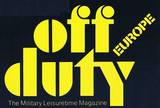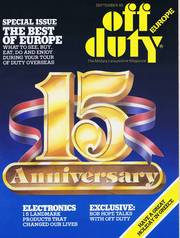"off duty" 1970 - 1997 - eine Freizeit-Zeitung für's US-Militär
Die in diesem amerikanischen (Freizeit-) Shopping-Magazin angepriesenen Hifi- und Video-Produkte waren auschließlich amerikanischen und kanadischen Militärangehörigen zugänglich - also zu kaufen - und vor allem zu ganz ungewöhnlich (verblüffend) niedrigen US $ Military-Preisen. Zu der einführenden "off duty" Seite geht es hier lang. - Um 1970 begann der weltweite Hifi-Boom bis zum 1. Crash 1978 und dann wieder zum 2.Crash um 1990. Über die 20 Jahre nach 2001 lesen Sie mehr in den Kolumnen auf diesen japanischen Seiten.
.
Das ist der spezielle Rückblick Artikel in dieser Ausgabe
Der Autor bezieht sich aber weniger auf auf die Entwicklung des Magazins off-duty an sich als auf die Entwicklung auf dem Hifi- und Audio-Markt.
.
THE DREAM A/V SYSTEM 1985
Der Autor Mike Michels schreibt zum 15-jährigen Jubiläum
If you assembled the best home entertainment system money can buy, this is what it might look like ...
In the course of working on this 15th Anniversary special issue of OFF DUTY, I paused to reflect on the fact that I have been lucky enough to be the magazine's technical editor for half of that time.
Although as an editor, I hate the term "state of the art" being part -engineer makes me realize that state has changed quite a bit since our first issue of September 1970.
Pictured on that magazine's cover was an ensemble of what could be considered a dream audio system. Let's take a look at what a dream electronic system would consist of then and now, and what it would cost. Stay tuned, you might be in for a pleasant surprise.
A typical audio system in 1970
A typical audio system bought by the typical GI stationed overseas was a good buy in 1970. Four-channel sound was just starting to make it into the spotlight at that time, but the concept, although a good one, fizzled because of lack of standards for quadraphonic systems.
There seemed to be a Million different approaches to 4-channel, and the consumer was understandably confused. As we'll see later, surround sound is making a healthy comeback, thanks to video - but we're getting ahead of ourselves.
So our 1970 system was really 2-channel stereo. At its heart was a receiver. The Kenwood KR7070A and the Sansui 2000 were popular units at the time. The Kenwood put out 80 watts per channel - considered colossal power output at the time - and the military discount price was $347.
German and British turntables pretty much ruled the waves back then. A popular Dual 1219 or Garrard SL series record changer was about $200, less base, dustcover and cartridge, which were almost universally sold separately.
Das SHURE V15 Typ II kostete US $ 46,50
The benchmark phono cartridge of the time was the Shure V15 type II, and it sold for $46.50 at the audio clubs. Also dominant were open reel tape machines. The cassette was new and had been originally designed for dictating machines and similar applications.
Instead, the 8-track cartridge was the format of choice for portables, especially car stereo. Teac, Akai and Revox were the big names in open reel decks (and still are). An Akai A4010GSL open reel deck sold for around $375.
There were a number of units that had both open reel and 8-track cartridge recorders built into the same unit — a unique feature you certainly don't see today.
"tape recorders" oder "decks"
Many of the tape machines then were known as "tape recorders" rather than "decks". The difference was that a tape recorder had built-in amplifiers and speakers and didn't require an audio support system, like a tape deck. The self-contained approach was relatively popular then, but this type of unit hasn't survived to the present.
There were a few cassette decks then. A really popular one of the early '70s (a friend of mine still uses hers) was the Teac A350. It was one of the first with Dolby and a switch for chrome tape. A top-loader, as all cassette decks were, it was listed in OFF DUTY's first Hi-Fi Annual — out yearly guide to military discount shopping overseas — at $179.
Finally, loudspeakers were a very important choice, then as now. The original Bose 901 was selling in 1970 at about $375 a pair. Bose was one of the first audio companies to actively seek out the military customer, and utilized innovative audio/video demonstrations, complete with light beams to show their product's unusual reflecting sound concept.
Another well-regarded speaker was the Acoustic Research LST (that's Laboratory Sound Transducer, not "Landing Ship Tank"), selling for around $400.
Alles zusammen kostete US $ 1,547.50
So adding up the cost of a good stereo system, we arrive at a total of $1,547.50. Now, let's see what a comparable system would cost at the Exchange today, keeping in mind that $1,547.50 represents a lot less today than it did 15 years ago.
Fangen wir heute neu an zu kalkulieren :
Der Plattenspieler
Looking through the current edition of the OFF DUTY Hi-Fi/Video Annual we find that a typical 80-watt receiver costs around $230. And that receiver is much more capable and sophisticated than one of 1970. It has digital tuning, preset station memory, station scan, cleaner power and more sensitive tuning.
Direct-drive Japanese turntables have pretty much taken over from the German makes in the popular price ranges. Furthermore, the old pivoting tone arm is long gone, replaced by a servo-driven linear-tracking tone arm that exactly duplicates the way the cutting stylus made the record. Base, dustcover and usually the cartridge are included, and the typical fully automatic unit sells for an amazingly low $ 130.
Das "cassette deck"
The cassette deck has taken over as the primary source of music for most music fans. In fact, prerecorded cassettes now slightly outsell phonograph records. The cassette deck is one area where there has been phenomenal improvement in the last 15 years.
Taking the same $179 spent in 1970 now gets us a fine two-head deck with Dolby B and C and dbx noise reduction, automatic reverse, music search, and specifications that exceed those of open reel decks in their heyday.
To make a fair comparison to our 1970 system, though, we really must include an open reel deck, although this component is much less popular than it was 15 years ago.
A moderately priced unit of about $400 from Teac or Akai would today have six heads and two speeds, automatic reverse, dbx noise reduction, capability for EE high-bias tape and variable pitch control. A whole lot for the money.
Die Lautsprecher
Speakers seem to be the one area where prices have gone up. This is partly due to the fact that so much wood and magnetic materials are used in their manufacture, and these things have skyrocketed in cost.
Also, unlike the strictly electronic components, which have benefited from miniaturized, integrated circuitry, loudspeakers are still relatively labor-intensive to build.
A pair of Bose 901 Series V's, including the active equalizer, cost $845. AR's top-of-the-line model 9LS will set you back $1,050 a pair. Nevertheless, good speakers can be had in the same $500 neighborhood of our 1970s speakers.
.
Summa Summarum in 1985 sind es US $1,784
So, total damages for a comparable 1985-style sound system come to $1,784, an increase of about $236. Considering that dollars today are worth much less than they were then and that the current system's sound quality and features would have seemed like science fiction in 1970, we can see that audio is quite a bargain (billiger Einkauf) today.
Ein heutiges "state-of-the-art system"
Today's state-of-the-art system, however, is something else. For starters, it isn't just an audio system. It's a home entertainment system, since it includes a video cassette recorder, video disc player, large screen monitor (not just a "TV"), video camera, video game or computer, digital audio compact disc player and tape deck — so many products that weren't even a gleam in a designer's eye in 1970.
Audio is, of course, an important part of the home entertainment experience. For a short while, video stole a lot of shine away from audio, but many VCR owners are discovering that they want the same sound that they hear in the theater — and that means Dolby stereo.
Dolby "surround stereo" is a system that encodes special information on the left and right stereo channels. This information is used by decoding circuits to create rear-channel and center-channel information in the better-equipped movie houses. Most films for the last 10 years have been released in Dolby stereo, and most stereo video cassette versions of these films have the necessary encoded information.
Bauen wir uns eines zusammen in 1985
So, let's assemble our dream, state-of-the-art home entertainment system.
Damn the cost, full speed ahead! (Someday maybe I can convince OFF DUTY's publisher that we need such a system here in the office for "research" purposes. Well, I can dream, can't I?)
Starting at the source, we would have a hi-fi stereo VCR, either Beta or VHS, or both. "Hi-fi" as opposed to just "stereo."
There were, for a while, some "stereo" VCRs that did indeed have left and right channels. But because these recorded the sound tracks onto the slow-moving video tape with fixed heads, wow and flutter were real problems, hiss was horrendous and frequency response was quite limited. "Mid-fi" would be a better description. Hi-fi stereo VCRs record sound the same way they record video, using the rotating head drum. This yields results that almost match the sound quality of the compact disc.
Since stereo broadcasting is currently coming on-line in the U.S., we'll want our VCR to have a stereo TV tuner as well. The stereo broadcast standard in the U.S. makes provision for a third channel, or "secondary audio program", that can be used for bilingual broadcasting or perhaps to send rear-channel signals for a surround-sound effect in the future.
Ein "laser disc player" gehört heute dazu
Since cost is no object, we'll also want a laser disc player. Laser discs offer the best available picture quality and good sound. A number of the newer releases have digital sound capability. Interactive discs are a fun way to play armchair quarterback or other games where the viewer makes a decision at a key juncture in the action and then the disc plays out the outcome, either good or bad.
The same laser technology used in the video disc is also used in the audio compact disc. We can get a separate CD player or perhaps Pioneer's unique all-in-one unit that plays all sizes of laser discs as well as compact discs.
We'll need some sort of central control system to tie all the video equipment together and select which source we'll feed to the monitor and the stereo sound system.
There are an increasing number of audio/video controllers and receivers on the market that handle all the audio/video switching chores simultaneously.
Und VIDEO muß auch dabei sein
Additional desirable features are color, tint and sharpness controls — the video equivalents of bass and treble controls. Since many video sources have mono sound, we'll want a good stereo synthesizer. Also nice would be dynamic range restoration and dynamic noise reduction to reduce hiss on our older collection of video cassettes as well as rental tapes, which tend to be pretty doggy.
The video equivalent of the loudspeaker is the TV or video monitor. I would opt for one of the new giant-size 35-inch picture tube sets that have recently made their appearance. They have large screens, but since they aren't projection TVs their picture is brighter, they can be viewed from off-center, and sunlight in the room doesn't make them hard to see. They are also big and expensive.
If your viewing distance isn't too great, a more conventional 26-inch monitor would be fine. We'll choose a monitor with direct video inputs and connect our VCR and other video sources directly to these, rather than using the more usual channel 3 or 4 RF inputs. When hooked up via an unused channel 3 or 4, the signal must be converted inside the VCR into a TV broadcast frequency, then piped to the TV or monitor, which then reconverts it back to a video signal. This degrades the quality too much for such a short trip.
Und auch ein Fernsehprojektor
If the viewing room is really big, a projection TV will be an option. There have been some great improvements in the brightness and picture quality of these units, and they're still the best for large groups and for rooms that can be conveniently darkened.
The sound from our video sources will be fed to a full-featured stereo preamplifier. It is important for this preamp to have abundant inputs and external loop circuits for outboard signal processors, since we will have a number of black-box sound processors.
Plugging into the preamp will be the following: the audio output of our audio/video sound processor, FM/AM stereo tuner (AM stereo also, since U.S. AM broadcasters are going both "left" and "right"), compact disc player, double cassette deck, open reel tape deck, linear-tracking direct-drive turntable. The tape monitor loops will be used for the cassette and open reel decks, of course.
Nicht zu vergessen - den Sound Prozessor
External processor loops will be necessary for our equalizer/analyzer. This combo product includes a test signal generator and a test microphone with which we can automatically adjust the frequency response of the audio system to suit our room's acoustics. Merely place the microphone at your favorite listening position and a brief test is conducted with the results stored in the EQ's memory.
A few other specialized black boxes will round out our audio system. We'll be using a dbx noise reduction unit with our open reel deck. To clean up our aging collections of phono albums, a tick and pop suppressor is a must, and a dbx dynamic range expander/ compressor will help us keep dynamic range under control.
The final outboard processor is a PCM adapter. "PCM" stands for pulse code modulation, another way of saying "digital." This gadget is an analog-to-digital and digital-to-analog converter that makes it possible to convert any music source into digital code and record it on our VCR, using the VCR strictly as a digital audio tape deck. To make perfectly faithful tape dubbings of compact discs, the PCM adapter is a must.
Der "Killer"-Verstärker und die Boxen
The output of our stereo preamplifier heads in two directions. The primary path is to a killer power amplifier that drives our two front speaker systems, which have been selected from among the cream of the speaker crop.
The preamp signal is also fed to a surround-sound decoder. This unit creates the Dolby theater surround sound that we mentioned before. It has a built-in power amplifier for the rear-channel speakers as well as a center dialog channel that helps fill in the gap between left and right speakers. For mono sound sources, the surround-sound unit also has a mono enhance circuit.
Finally, we'll want to take our video on the road, creating our own video home movies with a color video camera. Since I like to ski, I want a compact, all-in-one camcorder like the Sony Betamovie or the Panasonic VHS OmniMovie. These are full-featured auto-focus color cameras with built-in video cassette recorders that can accept a full-size standard video cassette.
Alles zusammen zu unseren Military lowcost Preisen .....
What's the total price tag? Figure over $10,000 at military exchange prices.
Good luck.



